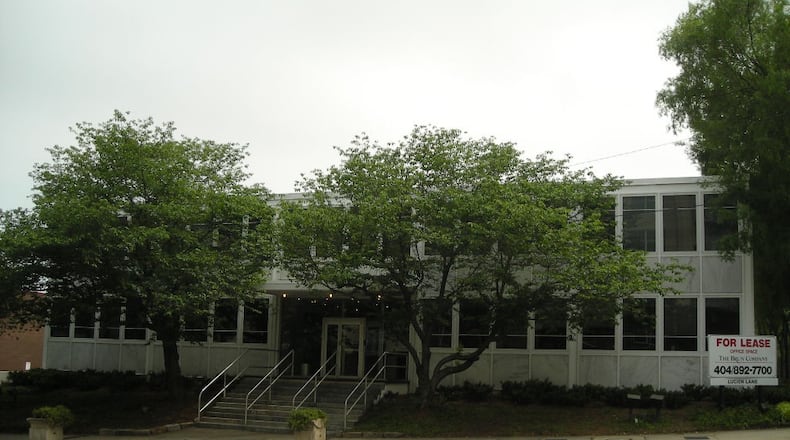I.M. Pei, one of the most celebrated architects in the world, has died at the age of 102, it was reported on Thursday.
Pei, a native of China, is perhaps best known for designing the huge glass pyramid entrance to the Louvre museum in Paris, a project that initially drew howls of disapproval from the French but has become one of the city's landmarks.
But one of his first projects, believed to be the first solo project of his career, was an office building in Atlanta, not far from the Fox Theatre.
In Atlanta, Pei's Midtown building, completed about 1951, came at the start of his career. It once housed the offices for Gulf Oil.
Pei designed at least one other building in Atlanta, according to his Web site: the Wildwood Plaza office building in Cobb County, which opened in 1991. The Atlanta Preservation Center also list a 1951 building at 46 Broad Street in downtown Atlanta.
Elsewhere in Georgia, Pei designed the Augusta/Richmond County Civic Center, (now called the James Brown Arena, the former Augusta Chamber of Commerce building and Broad Street Mall in Augusta, according to his web site.
The following story from the AJC archives was published in June 2007. The building was torn down in 2013.
RELATED: Read more about the life and legacy of I.M. Pei
> Read and sign the online guestbook for I.M. Pei
The original story:
June 22, 2007, by Paul Donsky
The low-slung Midtown office building is unassuming --- a blocky, two-story structure with a wide staircase in the middle.
But the post-World War II building has an illustrious provenance: It was designed by I.M. Pei, one of the most celebrated architects in the world.
It's also believed to be the first solo effort of Pei's career, and experts say it is an important example of midcentury modernism.
Now, developers want to bring a large mixed-use complex to the site, complete with two midrise towers and ground-level retail, raising concerns about the Pei building's future.
Those involved with the project say they intend to save the historic structure by either building around it or on top of it, though they acknowledge it's possible only the facade will survive.
Credit: W.A. BRIDGES JR.
Credit: W.A. BRIDGES JR.
"Our goal is to get as much of the building as possible incorporated into the new project," said David Green, an architect with Lord, Aeck & Sargent's Atlanta office.
The project team is even working to bring the 90-year-old Pei on board as a consultant to help preserve the building, said Green.
"The last thing we would ever do is be a part of a project that would be detrimental to a building like that," he said.
A call placed with Pei's assistant at the architect's Washington office on Thursday was not returned.
The property sits on a high-profile block east of Peachtree Street, between Ponce de Leon and North avenues, near the Fox Theatre and the Bank of America skyscraper.
Plans filed last week with the state call for two towers housing 1.3 million square feet of residential, hotel and office space.
The property owner, Paul Thomas, is seeking a rezoning that would allow him to build above 100 feet. Green said the project could reach 20 to 25 stories.
Thomas, owner of Thirty-Third Latitude Properties, stressed the project is in the formative stages. He's still lining up developers, with the final design far from being determined.
Pei, a native of China, is perhaps best known for designing the huge glass pyramid entrance to the Louvre museum in Paris, a project that initially drew howls of disapproval from the French but has become one of the city's landmarks.
Pei's Midtown building, completed more than in 1951, came at the start of his career.
It once housed the offices for Gulf Oil but in recent years has been leased by a variety of tenants, including Thomas' company, Thirty-Third Latitude.
In a city known for tearing down the old to make way for the new, the Gulf Oil building seems an unlikely survivor, at least to the casual observer. The stark, minimalist design features two horizontal rows of windows, a staircase out front and little else.
Modern architecture
But the building is considered a prime example of modernist architecture and is well worth saving, said Robert Craig, an architecture professor at Georgia Tech.
"We're too quick to dismiss minimal architecture as not having much content," he said.
But the Pei building "has this elegance of material and a really refined line that is very carefully proportioned," he said.
Craig said midcentury, modern buildings have been successfully saved from the wrecking ball in other cities. In Denver, he noted, a city office tower was built behind a 1949 classroom building.
Pei designed one other building in Atlanta, according to his Web site: the Wildwood Plaza office building in Cobb County, which opened in 1991.
Preliminary plans for the mixed-use project on the Gulf Oil building site became public last week, when developers filed papers with the state Department of Community Affairs, which oversees large proposed developments to ensure they will not overwhelm roads and sewers.
Tower to front Ponce
The plans show one of the towers fronting Ponce de Leon, where the Pei building now sits. Some historic preservationists worried that meant the Gulf Oil building would be torn down, and quickly geared up for a fight.
"The building has great significance, being the work of a master architect," said Tom Little, an Atlanta architect who is also president of DOCOMOMO Georgia, the local branch of an international group committed to saving modern buildings.
Few left from era
"Its significance has increased substantially because of the continuing loss of structures of that era in Midtown, downtown and even Buckhead," he added.
Last month, the Gulf Oil building was placed on the Atlanta Preservation Center's 2007 list of endangered buildings.
The mixed-use project continues the renaissance of Midtown's southern edge.
Credit: W.A. BRIDGES JR.
Credit: W.A. BRIDGES JR.
It's adjacent to Fox Plaza, a hotel-office complex planned by Cousins Properties. Cousins tore down a 12-story office building from 1959 to make way for that project.
Green, the project's architect, said great care will be taken to preserve Pei's building. Green is a member of DOCOMOMO and teaches architecture at Georgia Tech.
The building is "an excellent example of early '50s postwar architecture; it's really an elegantly designed building," he said. "We have to be sure that the essence of the building remains clean and clear."
About the Author
Keep Reading
The Latest
Featured





